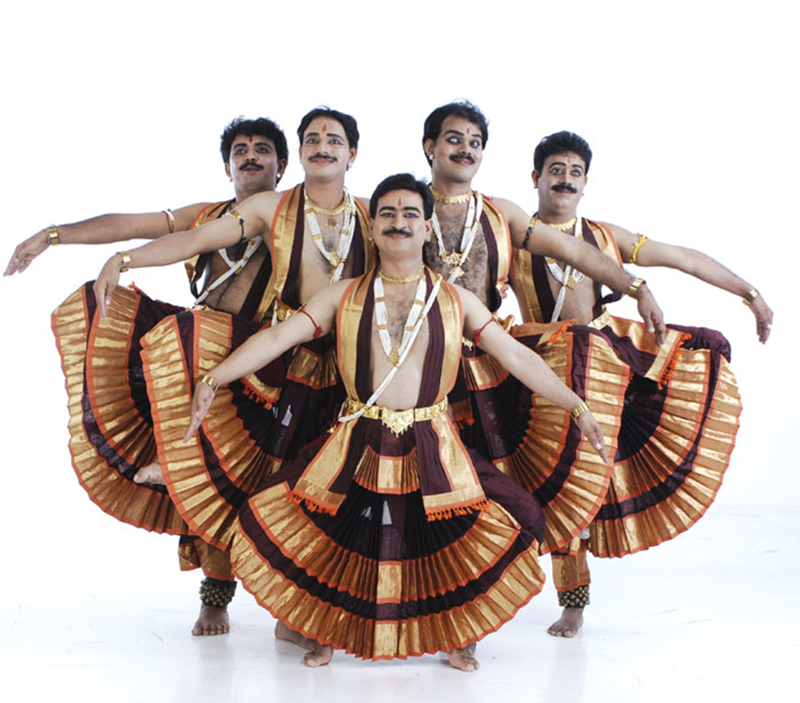The years-long path that brought five boys studying at the Ramana Maharishi Academy for the Blind Academy in Bangalore, India, to the University of Cincinnati for a performance Saturday is an amazing one. From such humble beginnings the group, today called Articulate Ability, is a veteran of more than 1,500 performances worldwide. Along with two sighted dancers, the blind men perform a panorama of Indian dance styles in Tamasoma Jyotir Gamaya: Darkness to Light.
After being attracted by rhythm and melody, the five first performed folk dance during an annual school day celebration in Bangalore. Last week, I spoke with their guru, teacher and choreographer, Mysore Nagaraj, by phone. Nagaraj, himself an established dancer, described how he first met the boys well more than 10 years ago.
“They were euphoric and happy after their first experience,” he says, “and the school hired a teacher who taught them the basics of the classical dance form and readied them with a few acts. But after graduating from school, they felt lost. They sought me out, and my colleague and I took them under our wing.”
Soon, Nagaraj felt the performers were capable of holding an audience as fully professional dance artists, and their touring career became a reality.
Sri Mirle, a research scientist for Procter & Gamble and a mentor to the UC student group Association for India’s Development since 2002, first encountered the group during a trip to India. He immediately wanted to support them by booking them to appear in one of AID’s cross-cultural programs in Cincinnati, which have been happening since 2002.
“It’s something that resonates with our idea of sustainable development — not giving them fish, but teaching them to fish,” Mirle says. “It was the idea of teaching them to be regular dancers, in a visual art form like dance. I think it’s inspiring for everyone — you don’t have to know much about Indian dance.”
Nagaraj remembers that when he began working with the young men there was no methodology to follow.
“However, if you are passionate about doing something it is never a pain,” he says. “Both the blind and ourselves as teachers put in lots of energy and time. It was not a smooth path. It demanded courage, perseverance and a belief in a deep-rooted dream to accomplish what some people think of as impossible — to have the public accept them first as artists, and then as people with disabilities.”
Classical Indian dance is ancient, with eight or so different recognized forms today. It is rooted in nuanced use of expression. For instance, there can be hundreds of hand gestures. To perform, it takes years of dedicated learning, similar to classical ballet. The Articulate Ability dancers are expert in Bharatanatyam, the classical dance of South India, but they also perform Kathak from North India, and folk, ritual, spiritual and tribal dances.
“Teaching the complex grammar of Bharatanatyam took nearly two years,” says Nagaraj. The main method used was tactile perception, much like teaching Braille. Each detail of movement was transmitted in this manner.
“Once having mastered the various nuances of the form,” he says, “it was then a smooth journey to induct them in compositions that demanded of them the ability to move across the stage in geometrically precise movement in space that they could not see. They challenged themselves to emote the lyrical compositions with expressions they have never seen. But when the dance unfolded across the stage, our dreams were fulfilled.”
Each of the blind dancers’ stories has a tragic aspect. For instance, one born with perfect sight got an infection from dust and was neglected by his family. Another became visually impaired from complications of typhoid.
“It was the pulsating rhythms of Indian percussion instruments, the melody in the song and musical instruments, and the moral that the lyrics conveyed in combination with freedom of movement that led them to embrace dance,” Nagaraj says.
In fact, the name “Tamasoma Jyotir Gamaya” reflects the ancient spiritual traditions that still persist in Indian dance, says Mirle. “The expression, ‘from darkness to light,’ can also expand to mean ‘lead me from untruth to truth,’ or even ‘lead me from death to immortality.’ ”
“It’s almost a benediction, or a prayer — to let ourselves become more deeply cognizant of our place in the cosmos. These dancers, though they are blind, bring an inner vision of that.”
ARTICULATE ABILITY performs Saturday at UC’s Tangeman University Center (reservations at cincinnati.aidindia.org) and presents a dance workshop Friday at Mason’s NrityArpana Studio (see nrityarpana.org).


